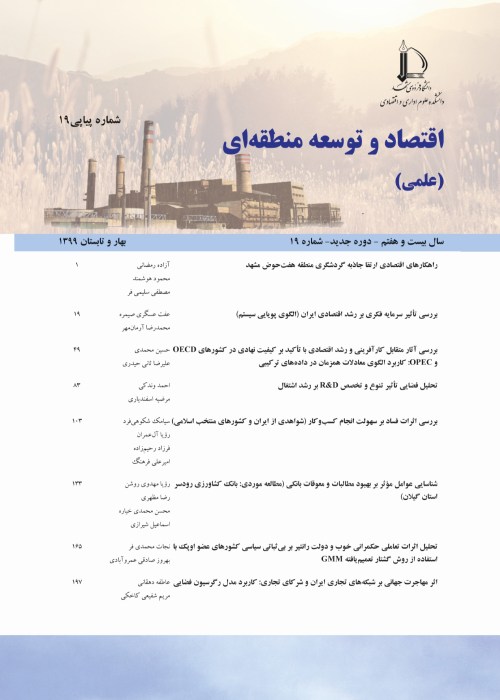Investigating the Effect of Inflation on Income Inequality of Urban Households in Iran Using the Atkinson Approach
Author(s):
Article Type:
Research/Original Article (دارای رتبه معتبر)
Abstract:
Introduction
This study investigates the changes in inequality caused by the direct impact of price changes of commodity groups among different income deciles of urban households in Iran. The importance of examining income inequality has forced governments to intervene in certain matters through the application of specific policies in terms of reducing economic inequality. The importance emanates from three aspects: 1) High income inequality not only causes the spread of economic instability but also it can hinder productivity growth; 2) In many studies, the reduction in income inequality is expressed in terms of growth and development. 3) The publication of statistics and extracts from poverty and economic inequity is important in centralizing people's attention to these issues.
Theoretical frame work:
Indicators of inequality used to measure income inequality in a community do not pay attention to the elements making up this inequality and the relative contribution of each of them in terms of total inequality of income. In order to implement a policy of reducing inequality, the determinants of this inequality must be identified so that a more effective policy can be applied by prioritizing their relative importance in creating inequality. It has been proved that inflation is one of the factors affecting income distribution, and its effect should be measured on its own as one of the factors affecting income inequality. In this research, Atkinson index has been used. The research data were collected during the period of 1372-1392 and time series. If the Atkinson income inequality function, instead of the income of households in each decade, uses the equivalent household income per decade, The amount that the Atkinson formula will show for income inequality represents the effect of the total inequality factors minus the direct effect of prices on income inequality. Therefore, the inequality of equivalent income is defined as the effect of the sum of factors influencing income inequality minus the direct effect of prices. In this research, the demand function estimation has been done using the method of linear expenditure system (LES). Due to the non-observance of the distorted sentences, the normal distribution, and the simultaneous effect of disrupting the variables on each other, the seemingly unrelated equations are used to estimate the parameters of the demand function.
Methodology
1) To derive the demand relation, the Ston-Garri utility function is used. We maximize the utility function by limiting the budget.2) Estimating the parameters of the demand function: One of the most important applications of SUR is to estimate the parameters of the consumption expenditure system of the household. In this study, there are eight major product categories, therefore, we will have eight equations
3)Extraction of equivalent income from the Ston-Garri function: After estimating the parameters, we obtain the equivalent income.It is the amount of income(expenditures), which is at the same level of the utility of original income (expenditures) (before the price change).This is presented at the level of new prices and is called equivalent revenue.
4( Calculation of Atkinson's inequality
5) The steps of calculating the direct effect of price changes on inequality
Results & Discussion
the direct influence of inflation (price changes) on income inequality is calculated. The average calculated value of this effect during the studied period is 48.8%, and this average represents the share of price changes or the share of inflation in income inequality. Therefore, commodity price changes (inflation) are the most fundamental factor in the variation in income inequality.
Conclusion
To solve the problem of income inequality, it is necessary to understand the constituent elements of the income inequality and the share of each of them in the total income inequality. The results indicate that the great price increase (high inflation) increases inequality. In addition, of the effective factors, increasing the price (inflation) has had the greatest impact on income inequality (almost 49 percent), while the remaining 51 percent relates to the rest of the factors (tax system, employment level, etc.) which are linked to the change in inequality. Regarding the above percentage, it is safe to say that price changes or inflation is one of the main factors accounting for the change in income inequality. Therefore, what policy makers should do to eliminate income inequality is to do their best to avoid inflationary policies.Keywords:
Language:
Persian
Published:
Journal of Economy and Regional Development, Volume:25 Issue: 15, 2018
Pages:
127 to 152
magiran.com/p1902579
دانلود و مطالعه متن این مقاله با یکی از روشهای زیر امکان پذیر است:
اشتراک شخصی
با عضویت و پرداخت آنلاین حق اشتراک یکساله به مبلغ 1,390,000ريال میتوانید 70 عنوان مطلب دانلود کنید!
اشتراک سازمانی
به کتابخانه دانشگاه یا محل کار خود پیشنهاد کنید تا اشتراک سازمانی این پایگاه را برای دسترسی نامحدود همه کاربران به متن مطالب تهیه نمایند!
توجه!
- حق عضویت دریافتی صرف حمایت از نشریات عضو و نگهداری، تکمیل و توسعه مگیران میشود.
- پرداخت حق اشتراک و دانلود مقالات اجازه بازنشر آن در سایر رسانههای چاپی و دیجیتال را به کاربر نمیدهد.
In order to view content subscription is required
Personal subscription
Subscribe magiran.com for 70 € euros via PayPal and download 70 articles during a year.
Organization subscription
Please contact us to subscribe your university or library for unlimited access!


